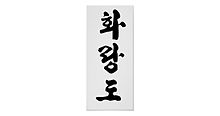Hwarang-do
 |
|
| Focus | Striking, Grappling, Weapons, Hybrid |
|---|---|
| Hardness | Semi-Full Contact |
| Country of origin |
|
| Creator | Joo Bang Lee, Joo Sang Lee |
| Parenthood | Korean martial arts |
| Ancestor arts | Um-Yang Kwon, Daitō-ryū Aiki-jūjutsu, Yudo, Kumdo |
| Olympic sport | No |
| Hwa Rang Do | |
| Hangul | 화랑도 |
|---|---|
| Hanja | |
| Revised Romanization | Hwarangdo |
| McCune–Reischauer | Hwarangdo |
Hwa Rang Do, also known as "The Way of the Flowering Knights" (Hangul: 화랑도; Hanja: 花郞道) is a comprehensive Korean martial art that was developed in the 1960s by Joo Bang Lee and his brother Joo Sang Lee. Hwa Rang Do as a martial art has multiple areas of focus including stand up fighting with open-hand striking, weapons, throws and takedowns, ground fighting, various types of meditative practices, intellectual and character development, and artistic and cultural pursuits.
The martial art of Hwa Rang Do was named after a buddhist elite youth order of the Silla kingdom during the Three-Kingdoms Period in what is now South Korea. These young men known as Hwarang (화랑; 花郎) were cultivated from a young age to fill significant roles in politics, civil service, and the military duties. These individuals were selected exclusively from the royal family and aristocracy and led members of the broader public who were described as Nangdo (Rang-do: 낭도; 郎徒). This group through various names lasted through the Koryŏ Dynasty until they were officially disbanded at the beginning of the Joseon Dynasty.
The modern martial art of Hwa Rang Do was founded by two Korean brothers, Joo Bang Lee and Joo Sang Lee, who started their martial art training with their father who taught them Yudo and Kumdo at a young age. In 1942, their father worked out a deal with a monk locally known as Suahm Dosa to educate his sons in traditional Korean cultural training. Suahm Dosa claimed to practice within a tradition that had its roots with the ancient Hwarang, which he called Um-Yang Kwon (음앙권; 陰陽拳). (Note that "Dosa" is actually his title, not his name. It is roughly equivalent to "hermit sage expert".) Both Joo Bang Lee and his brother Joo Sang Lee trained with Suahm Dosa at the Suk Wang Sa Temple in the Ham Nam province of North Korea, before the breakout of the Korean War and they had to flee south to avoid the communist military. The Lee family relocated to Seoul and Suahm Dosa, according to the Lee family, relocated to Ohdae Mountain.
The Lee brothers continued their training with Suahm Dosa when they could until 1950 when their family moved further south to Daegu. Being too far away to continue their training with Suahm Dosa, they began to be involved with the local martial art communities in the area. There, they met a martial artist named Choi Yong-sool, a practitioner of Daitō-ryū Aiki-jūjutsu and who is recognized as the founder of modern Hapkido. They continued their training with Choi through the 1950s and became registered Hapkido instructors in Seoul in the early 1960s. It was also around 1960 when the Lee brothers became involved with a Kung Fu practitioner named Suh In-Hyuk, who was in the early development of a Korean martial art called Kuk Sool Won. Their involvement with Suh In-Hyuk ended in the mid 60s and the Lee brothers continued to work within the Hapkido community until 1968.
...
Wikipedia
